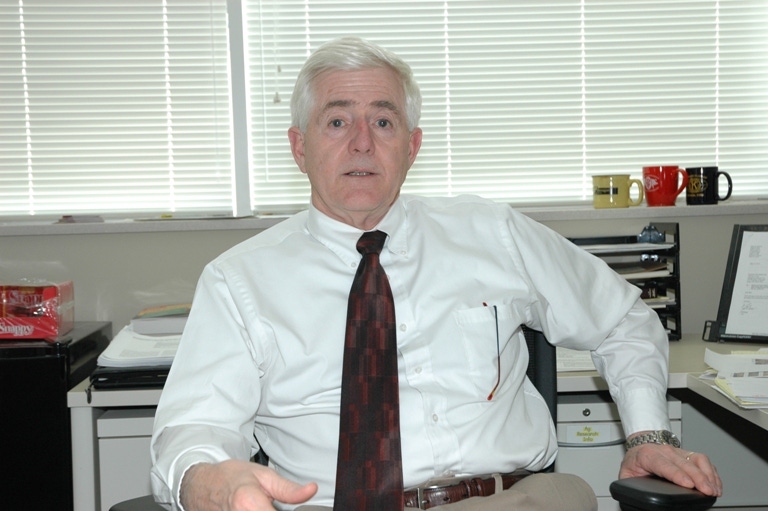2013 Master of the Pork Industry Rodney “Butch” Baker, DVM
A lifelong learner, this Kentucky native has enjoyed the challenges of changing careers.

For Rodney “Butch” Baker, DVM — despite a long, respected career as a consulting swine veterinarian practicing in several states — in his mind he had not reached the pinnacle of success until seven years ago, when he joined Iowa State University (ISU) in Ames.
No matter where in the world someone hails from, ISU is known as “swine central” — the mecca of swine production and education, Baker explains in his persistent southern drawl. “The move here has really been the best thing that has happened to me in my career — it is such a great place,” he says.
Baker serves as a senior clinician and holds the Dr. David R. Trask Professorship in Entrepreneurial Studies in the Veterinary Diagnostic & Production Animal Medicine Department in the ISU College of Veterinary Medicine.
In his teaching appointment, he assists fellow swine veterinarians, Locke Karriker and Alex Ramirez, in the swine medicine rotation, also giving lectures on a variety of subjects in other veterinary medicine courses.
He and Ramirez teach a livestock disease prevention class in the Animal Science Department, which is a pre-vet class that Baker started.
“It had been a class that was on the books, but no one had taught it for a number of years, so I just changed it and re-birthed it,” Baker explains. The first year the class was offered, only 19 students showed up. This past semester, 71 students were enrolled.
The class has grown simply by word of mouth. The goal is to teach pre-vet students many of the principles about animal agriculture, including pharmacology, vaccines, antibiotics, specific species health concerns and current health and welfare issues.
Last October, Baker was appointed to serve as interim director of the Iowa Pork Industry Center. He has agreed to serve in that capacity until June 2014, when he turns 67 years old.
Real-World Readiness
Another initiative Baker has spearheaded at ISU is an effort to teach college kids how to make a living after graduation.
“In the United States, our average veterinary medical student graduates with nearly $150,000 in student debt, which is a huge issue for them. I teach veterinary entrepreneurship and veterinary practice management, which are two different elective classes designed to help these kids deal with debt,” he explains.
Part of the problem stems from a lack of state and federal support. “At one time, our land-grant universities were primarily taxpayer-sponsored. We have gradually become more like private universities, which are state-supported rather than state-financed,” he points out. Currently, well under 50% of the money that is allocated to ISU comes from the state Legislature and granting organizations, compared to around 80% funding about a decade ago. We’ve been forced to raise tuition every year that I’ve been here until this year, when our new [ISU] president promised students that he would not approve additional increases,” Baker says.
Like what you’re reading? Subscribe to the National Hog Farmer Weekly Wrap Up newsletter and get the latest news delivered right to your inbox every Friday!
Bucking a national trend, many of the current ISU veterinary graduates want to pursue a mixed or food-animal practice, while most veterinary schools are putting out companion-animal practitioners, he explains. “Iowa State is one of the last colleges that truly has a complete program for all species including dairy, beef cow-calf, beef feedlot, swine and poultry,” he says.
Family Research Project
More a clinician than a researcher, Baker is involved for the first time in a research project with daughter Amy Vincent, DVM, known as the “flu queen” for her in-depth expertise on influenza worldwide. She is a veterinary medical officer with USDA’s National Animal Disease Center in Ames.
Baker and Vincent are teaming up with ISU’s Phil Gauger, DVM, who secured a grant to gain a better understanding of influenza dynamics in pigs.
Seasonal influenza has changed the last few years, Baker explains. Now farms are experiencing year-round episodes, including baby pigs expressing preweaning signs of influenza, such as coughing, while the sows remain normal. Equally unusual, influenza virus is being recovered from these baby pigs as they move into the nursery at weaning, where they often break again with clinical disease.
“We know that the piglet is carrying that virus into the nursery, and we want to know if there may be some association with sow vaccination. My theory is that we may be tricking the sow’s immune system into making the wrong antibodies, and this is causing the field virus to stay active in the baby pigs. We hope to better understand this,” Baker notes.
The pig has long been considered the mixing vessel for influenza, but in reality, it is largely people who are responsible for the dynamic changes in recent swine influenza viruses, he continues.
“A lot of the genetics in our swine flu viruses today have come from people and birds. It is easier for the virus to cross from humans to pigs than the other way around,” he says. The mixing has kept the virus dynamic, and has stymied the ability of commercial vaccines to closely match field strains of the virus and get positive results.
When swine vaccines match field strains, the results are far better compared with seasonal human flu vaccines, Baker says, because swine vaccines produce stronger immune response through the use of adjuvants, substances that are added to the vaccine to increase the immune response.
Even so, the challenge to match vaccine to field isolates is ongoing, he admits.
PRRS Efforts
Baker has also played a critical industry role in control efforts for porcine reproductive and respiratory syndrome (PRRS) virus. While working at PIC as director of health assurance, the breeding stock company developed farm closure and rollover efforts, which was the first successful herd eradication method.
“Hank Harris, DVM, [now with Iowa State University and Harris Vaccines] and Bill Christensen of PIC came up with the idea that we could eradicate the virus from PIC by temporarily closing herds to gilt introductions and doing off-site breeding projects, provided growing pigs weren’t kept on the site,” Baker recalls. Montse Torremorell, DVM, and Marie Gramer, DVM, both on staff at the University of Minnesota, got the job done in the field.
Baker also helped a number of 5,000-sow and 10,000-sow operations duplicate PIC’s results, and helped with PRRS cleanup when he worked at Premium Standard Farms (PSF) in North Carolina and Missouri.
He gained some recognition while at PSF in Missouri when he adapted some poultry research from David Reeves, DVM, University of Georgia. His heat drying system developed in collaboration with PIC to eliminate PRRS virus in transport trucks became known as the “Trailer Baker.” Heating hog transport trailers to 165° F for 10 minutes inactivates PRRS virus along with many other microbial pathogens, he explains.
“That is the core temperature for cooking ground meat products to inactivate E. coli and other bacteria. That was our goal, and right out of the gate it worked to inactivate PRRS, transmissible gastroenteritis [TGE] and enteric bacteria,” he says. Later work proved that heating the trailer to 150° F for 10 minutes also inactivated PRRS virus. Today, Automated Production Systems sells a similar system under the trademark Bio-Dry.
The Iowa State veterinarian says the PIC herd elimination strategy, along with tools such as rope sampling, serum inoculation, area vaccination, trailer disinfection techniques, farm filtration, producer collaboration, risk assessment and the Trailer Baker, makes PRRS eradication feasible.

“We have the tools, including the cotton ropes, we understand biosecurity, and we know how to eliminate the virus from sow farms. And we understand the risk of airborne virus in super-dense hog areas. But certainly the role of trucks and people are important to understand if we want to fix this issue,” Baker proclaims.
Also on the swine health front, Baker envisions new vaccine platforms will offer better PRRS, influenza and other economically important disease agent controls.
He suggests the industry return to eradicating economically important diseases. “We went through a period in this country where we eradicated hog cholera, pseudorabies and swine brucellosis. But since then we haven’t had a lot of interest in eradication.” He expects interest in eradication to grow as pressure mounts to limit the use of antibiotics in swine production.
“I expect greater emphasis on eradication of different swine diseases as we develop a greater focus on biosecurity and, hopefully, have a better understanding of what we really need to do to keep diseases out of our farms,” Baker says.
A Born Veterinarian
A native of Owensboro, KY, Baker was raised on a small farm with cattle, pigs, sheep and often other critters. He recalls fondly how much his dad cared about all animals. Once his father splinted a broken dove’s wing before eventually releasing it back into the wild — and then seeing what appeared to be the same dove the next spring, nesting on the ledge of their porch.
During his youth, a friend’s mother repeatedly told him that he should aspire to become a veterinarian because he had developed such a strong bond with their family’s pets. It was an inspiration that has never faded.
When he applied to veterinary colleges, the family’s local veterinarian, who had gone on to become Kentucky’s state veterinarian, wrote a letter of recommendation for him to enroll at Auburn University, where he received his DVM degree.
From there, Baker spent 20 years in private practice at Bowling Green, KY, focusing on companion- and food-animal medicine, with the last 10 years solely as a swine practitioner. He recalls meeting a young and energetic Steve Henry, DVM, at a Swine Day presentation, where Henry was the keynote speaker, at the Murray State University Diagnostic Lab in Hopkinsville, KY. His message that stuck with Baker was to always grow intellectually and do more for your clients. Henry remains an inspiration, Baker says.
One client, a Georgia pork producer, turned out to be a business partner. Baker advised the producer to bulldoze his old hog operation and build a new, modern one. One night the producer called, asking if Baker would invest in the new operation. Baker and a veterinary partner invested in the 2,400-sow, breed-to-wean operation that produces pigs on contract for one of the large integrators. “It has been a home run for us,” Baker says.
Baker and veterinary partners also own a hog farm in Kentucky, leased to Cargill Meat Solutions, that operates as a sow welfare research farm featuring loose sow housing.
During his years of private practice (1978 to 1998), he and his partners built two veterinary clinics and purchased a third.
Partially responsible for putting an end to his private practice was the decline of the feeder pig business in central Kentucky. “I was really interested in doing more swine work, and through the late ’70s and early ’80s we had a lot of small feeder pig producers. That market went away by the early 1990s,” he says.
In the mid-’90s, Baker completed the University of Illinois’ Executive Veterinary Program in swine production management. Then he attended Iowa State University where he received a practice-based master of science degree in veterinary diagnostics and production animal medicine in 1999.
Seeking more challenges, he spent a year as a technical services veterinarian for Bayer Animal Health, followed by a stint at PIC, then served as director of health assurance for Premium Standard Farms.
Those vocations were rewarding, but lacked the research resources afforded by university life. When North Carolina State University recruited him to become associate clinical professor at the College of Veterinary Medicine, it was the opportunity that he had hoped would come at the end of his career.
Only a year and a half later, Iowa State University (ISU) came calling, urging him to join his daughter in Ames. Having just settled in Raleigh, NC, he wasn’t eager to move, but Iowa State’s persistence prevailed.
Just as he was mentored by industry giants, such as Henry and Harris; Bob Glock, DVM; the late Ken Woolley of PIC; and Pat Halbur, DVM, of ISU, among others, so too has Baker mentored a number of students for which he has also been enriched.
Besides his family, one of the most motivating experiences for Baker has been his involvement in the American Association of Swine Veterinarians (AASV).
“I have always been active in AASV and it has meant a lot to me in my career. The greatest thing about the annual convention, which was just held in March in San Diego, was to get to be with my friends once again, because almost all of my friends are associated with AASV,” he says.
While living in Kentucky, he recalls fondly running for AASV district director. “I realized there was not much chance that a Kentucky practitioner was going to ever win an election running against the Midwestern veterinarians. But when I moved to Ames, I suddenly became one of them, was nominated to run as AASV vice president and eventually became the president in 2009,” Baker says.
Following the 2013 AASV convention, he and fellow Past President Paul Ruen, DVM, of the Fairmont (MN) Vet Clinic, went sailing in the ocean off the San Diego Harbor to partake in another of Baker’s pleasure.
Now as his career winds down, there are bound to be some professional regrets. But there will be more personal time for his wife, Emma, and for the grandchildren — and more time for sailing south.
— Joe Vansickle
You might also like:
2013 Master of the Pork Industry Bradley Wolter
2013 Master of the Pork Industry Malcolm DeKryger
2013 Master of the Pork Industry Bob Thaler
2013 Master of the Pork Industry Jim Meimann
2013 Master of the Pork Industry Rodney “Butch” Baker, DVM
2013 Master of the Pork Industry Jeff Hansen
About the Author(s)
You May Also Like





